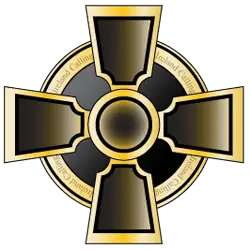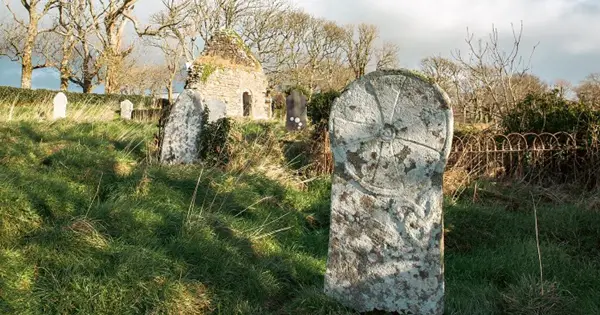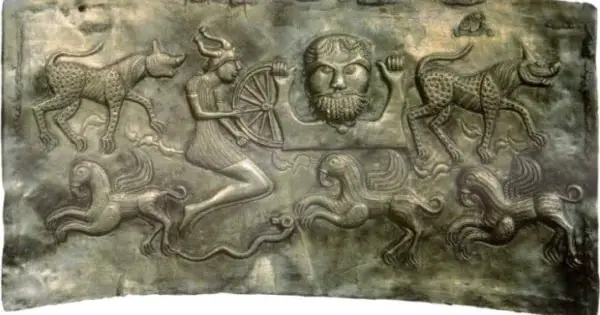The Celtic cross is a symbol of both culture and faith. The true origins are unknown but there are many theories and legends.
Two cultures combined

One Christian legend says that the first Celtic cross was formed by Saint Patrick while bringing Christianity to the Druids. The Druids used to worship a large circular stone. Saint Patrick, on seeing the significance of this stone, drew a large cross through the middle of it in order to bless it.
From this act, the two cultures combined to form the Celtic cross. The cross represents Christianity and the circle is the Celtic representation of eternity, with no beginning and no end.
The Celtic Cross predates Christianity
However, there are many different theories on the cross and its meanings. One suggests that the cross represents the four directions of north, south, east and west or the four elements; earth, fire, air and water.

The cross could also symbolise the connections between life, nature, and the spiritual world. The Celts were people deeply connected to nature and the seasons. The cross’s shape is very similar to a solar calendar showing the four seasons, the solstices and the equinoxes.
So the circle would represent the sun’s eternal journey through the seasons with the vertical arms representing the solstices and the horizontal, the equinoxes.
This would suggest that the symbol of the cross predates Christianity and indeed it does appear in many ancient cultures in one form or another. Carvings of crosses can even be found in caves around the world, dating back to the Stone Age.

Of course, there is also the suggestion that the circle around the cross is merely a structural addition to add strength to the four arms of the Christian cross. However, early Celtic crosses, such as the Killaghtee Cross, Co. Donegal, were carved into flat stones rather than formed into cross shapes.
Sun Cross to Celtic Cross

The Celtic cross may be a combination of two symbols: the traditional Christian cross and the sun cross.
Before Christianity came to Ireland, the Gaelic people worshipped a number of different gods. One of these gods was Taranis, God of Thunder, who was often represented holding a thunderbolt in one hand and a wheel in the other.

During the Bronze Age, this wheel was often depicted on Celtic coins or worn as jewellery. It usually had four spokes and was known as the sun cross. The two symbols are very similar which suggests the sun cross may have evolved into the Celtic cross over time.
As Christianity spread across the Celtic lands, the cross became a means to bridge the old pagan traditions with the new Christian faith. By incorporating elements of both belief systems, the Celtic cross became a powerful representation of the cultural and spiritual fusion occurring during this period. It also served as a way to help convert the local population to Christianity by making the faith more relatable and familiar.
Symbol of Celtic heritage

The Celtic cross travelled through history, changing as it went. As Christianity spread across Europe, the cross became important in religious and everyday life. In Ireland and the British Isles, it marked graves and special places, connecting people to the land and their ancestors.
Irish monks took it with them as they travelled, setting up churches and monasteries in faraway lands. This made the symbol a way to share ideas between different cultures.
The origins may be pagan but it was championed by Christianity in the form of the high crosses around the countryside and in the illuminated manuscripts.
Intricate Artwork

The artwork on the Celtic cross draws inspiration from a variety of sources, including Celtic, Christian, and possibly some Viking influences, especially in certain regions where these cultures interacted. The intricate designs and patterns found on Celtic crosses are a result of a unique blend of artistic styles and symbolic meanings.
Celtic Art

Celtic art is characterised by its intricate knotwork, spirals, interlacing patterns, and animal motifs. What we think of as Celtic art today was actually a fusion of the Celtic designs inspired by nature and spirals and art from the migrating European tribes who introduced the interwoven knotwork into the mix. This style of art was used in metalwork, and wood and stone carvings. It reflected the connection between nature, life, and spirituality in Celtic beliefs.
Christian Art

With the spread of Christianity in Celtic lands, Christian symbols and stories began to intertwine with existing Celtic art. This can be seen in illuminated manuscripts such as the Book of Kells as well as on Celtic crosses, often illustrated with biblical scenes among Celtic symbols and knotwork. This shows the effort to merge Christian beliefs with the existing culture.
Viking Art

In certain regions where Viking and Celtic cultures interacted, there are indications that Viking art might have influenced the design of some Celtic crosses. The Vikings, known for their seafaring and trading, brought their own artistic styles to various areas, including parts of the British Isles and Ireland.
Manx rune stones are a fascinating example of this cultural fusion. The Isle of Man, located in the Irish Sea, has a rich history of Celtic and Norse influences due to its location and history of settlement. These stones typically feature runic inscriptions, which are associated with Norse culture, combined with the design of the Celtic cross.
The Celtic Cross Today

The majority of the people who use the Celtic cross symbol today are Christian but many people also wear pendants as a symbol of their Irish (or Scottish or Welsh) heritage. For many, the cross connects them to their ancestors, giving them a sense of belonging and understanding.
Its design is captivating, leading to its use in jewellery, tattoos, architecture, and even fashion. The cross’s beauty and deep meaning make it a symbol that goes beyond religion. Ultimately, the meaning of the cross can vary based on individual beliefs, cultural backgrounds, and personal interpretations.
Starting from its mysterious beginnings to today, it has changed but not lost its core ideas. It’s a symbol of how spirituality, culture, and art come together, bridging the past, present, and future.
Celtic Cross FAQ
It is not inherently Protestant or Catholic. It is a symbol that predates the division between Protestantism and Catholicism and has been used by both Christian denominations.
The cross likely emerged as a result of the interaction between Christianity and pre-existing Celtic beliefs, well before the Viking Age. However, it is worth noting that Viking influences did have an impact on the design of some Celtic Crosses, particularly in areas where Viking and Celtic cultures came into contact.
In a Christian context, the cross is often used to represent Jesus Christ and his crucifixion. The circle that often surrounds the intersection of the cross arms represents eternity and God’s infinite love, reinforcing the idea of Jesus’s resurrection and the promise of eternal life.
No. While the symbol has historical ties to Celtic lands, particularly Ireland, it has become a widely recognised and appreciated symbol around the world.
Many individuals, regardless of their ethnic background, wear the Celtic Cross as a piece of jewellery, a tattoo, or in other forms as a way to express their personal beliefs, commemorate loved ones, or appreciate the symbol’s aesthetic beauty.
The Carndonagh Cross, on the Inishowen Peninsula, County Donegal is possibly the oldest surviving cross in Ireland. Saint Patrick is said to have built a monastery here during the 5th century AD.
Click here for Celtic cross jewellery
How to make an origami Celtic cross
Celtic Cross Designs from Bealtaine Fire

